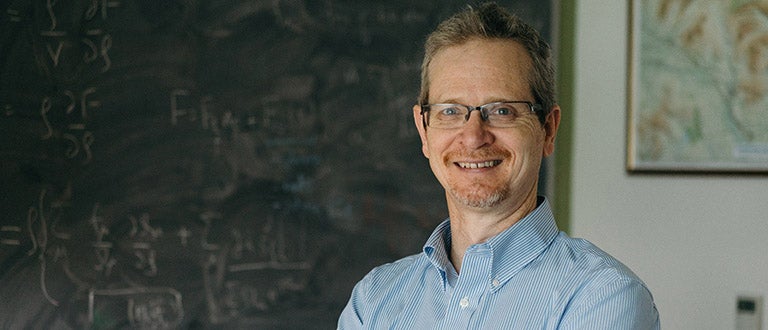Science Departments, NIST Establish Grant Framework

Professor Peter Olmsted, Georgetown College’s Professor and Josephes Semmes Ives Chair in Physics and main liaison with NIST for the new PREP grant framework. Photo by Kuna Malik Hamad.
June 21, 2016 — Sometimes, important research in the field of physics deals with complex, abstract theories, nearly incomprehensible without training and holding immense ramifications on the nature of matter itself. Other times, it deals with things we see every day.
This is one of the latter stories, but it’s no less fascinating.
Georgetown College has established a new framework for collaboration with the National Institute of Standards and Technology (NIST) in Gaithersburg, Md., which will allow the agency to more easily collaborate with the University. The initiative begins with NIST’s Materials Measurement Laboratory, but is likely to be extended to the entire Gaithersburg campus by the end of the year.
The Professional Research and Experience Program (PREP) designates up to $1.5 million in NIST funding each year for up to five years. It’s not a flat check each year, but rather an avenue through which the agency’s resources can flexibly be applied to collaborative research with Georgetown University.
“It enables them to more easily utilize their internal resources to collaborate with us,” said Peter Olmsted, who holds the Professor and Joseph Semmes Ives Chair in Physics and serves as the PREP’s main liaison with NIST. “Prior to this grant, we’ve benefited from these collaborations, but with every interaction arranged and executed separately. This enables us to put all our contracts under the same umbrella and unites much of the administration under one roof.”
NIST has supported and will continue to support a wide range of research at Georgetown. Olmsted’s work on 3D printing is one example; Professor Jeff Urbach’s research on reinforcing polymeric materials with nanomaterials is another.
Professor Daniel Blair is using neutron scattering to understand high shear flow of complex fluids in microfluidic devices with the purpose of understanding drug delivery. He recently made national headlines when another collaborative project helped to explain the science behind the perennial science-fair star “oobleck.”
Professor Emanuela Del Gado is studying a vital but rarely lauded material: cement.
“Cement sounds like a boring material, but part of that is because we’re so familiar with it — it’s the most-used material by humans, by volume,” Olmsted said. “It also produces something like 8 percent of CO2 emissions in the process of making it. So if you can understand how to make it without dumping CO2 in the environment, that’s useful.”
All Georgetown researchers will be able to apply for funding through PREP, but it was developed primarily by professors from the Institute for Soft Matter Synthesis and Metrology, a collaboration between the physics and chemistry departments that focuses on the study of soft matter. Chemistry Department Chair YuYe Tong’s longstanding collaboration with NIST on nanomaterials for surface applications such as catalysis will also continue under PREP.
“A strong focus of the NIST collaboration is devoted to soft materials — polymers, biomaterials, shampoos, soaps, plastics, most of the things we use in real life,” Olmsted said. “But [PREP] isn’t solely restricted to soft-matter professors or those named in the proposal. … Anyone at the university, whether they are named in the initial grant or not, is able to take advantage of it if they can find links.”
The framework makes the NIST’s funding and facilities — its nuclear reactor, for example, which allows detailed polymer and condensed matter study via neutron scattering — more readily available to researchers specializing in molecular-level material analysis.
To help things move even more smoothly, Olmsted is in the process of developing a “menu” complete with the cost for supporting researchers at all levels. This way, NIST can consult one document to figure out how much it costs to fund, say, a physics PhD candidate for one year, a chemistry professor on teaching sabbatical, or any other funding recipient.
Under PREP, Olmsted also hopes to speed up the implementation of a brand-new partnership: an undergraduate intern program, modeled after the Colorado NIST laboratory’s successful partnership with Colorado University at Boulder.
PREP hasn’t received any funding as of this publishing, but given NIST’s history with Georgetown and the Institute for Soft Matter, it’s only a matter of time. And the results of this partnership may well have major implications for the materials we consume, wear, and use every day.
“From buildings to medicine, food or cosmetics, soft matter science truly has an impact on any materials we may use and hence has a unique potential to improve their efficacity, efficiency and sustainability,” Olmsted said. “There’s a tremendous amount of science behind that.”